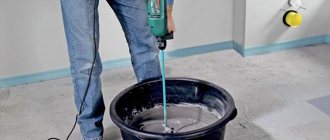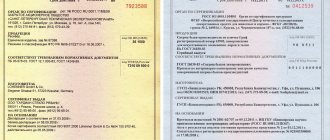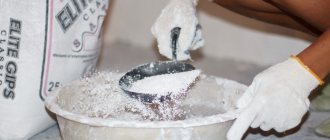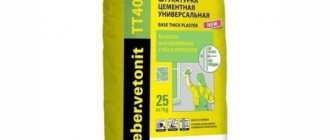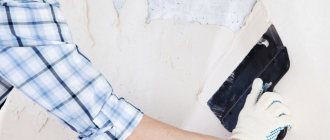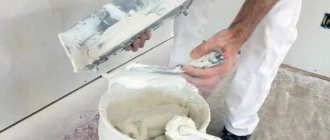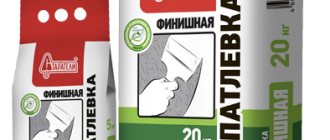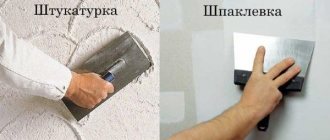13092 0 4
Andrey June 12, 2017 Specialization: facade finishing, interior finishing, construction of dachas, garages. Experience of an amateur gardener and gardener. We also have experience in repairing cars and motorcycles. Hobbies: playing the guitar and many other things that I don’t have time for :)
What is polyester putty with fiberglass, what properties and characteristics does it have? Since I often have to work with this material, I will answer these questions. In addition, I will tell you for what purposes this material can be used.
Polyester putty is a widely used material for leveling metal surfaces.
General information about the material
Fiberglass putty is a composition based on an unsaturated modified polyester resin, reinforced with special fibers and is a two-component product. In its original form, any polyester resin is quite hard, so various targeted additives are added to it to enhance ductility and elasticity. The fiberglass in the putty is intended to further enhance the strength of the material after drying.
Putty composition
Fiberglass will protect the coating from cracking.
Fiberglass putty gives the material plasticity and participates in polymerization processes. The mixture is made based on a special resin.
Small fiberglass threads are added to the composition as a reinforcing additive. They protect the applied composition from cracking and shrinkage.
Styrene is used as a solvent. The mixture is kept tightly closed so that the solvent does not evaporate.
Hardener for putty is sold separately. It is mixed with the mass before application, which promotes crystallization of the mixture.
Putty composition
The main active substance of the putty is polyester resin - a viscous mass that is a little reminiscent of honey. It plays the role of a binding component and ensures the strength of the finished mixture. The composition also includes fiberglass particles that reinforce the mass and act as a filler. They increase the hardness of the coating after drying, so that it does not shrink and cracks do not appear.
Depending on the production technology, glass fiber threads are:
- Long. They are created in a continuous production process where molten glass is turned into thin streams and wound onto a drum. After hardening, the fibers pass through a special installation, where they are coated with an emulsion of starch, gelatin and plasticizers.
- Short. They are obtained by blowing liquid glass with steam or air. The finished fibers are short in length and resemble wool.
Fiberglass fiber
Most often, short reinforcing fibers are used in the production of putty. The material also contains styrene, which enhances elasticity. A hardener is sold in a separate package - this liquid substance, after mixing with the base, starts a chemical polymerization reaction, and the putty begins to harden.
What is classic polyester putty?
Automotive putty is a paste-like material for removing irregularities and dents on body parts before painting. Classic polyester putty consists of two main groups of substances:
- Resins based on modified polyester chemical compounds that determine the plasticity and viscosity, adhesion and polymerization rate of the material.
- Fillers based on mineral insoluble components that affect the strength properties and complexity of further processing of the layer applied to metal or plastic.
When resins and filler are combined, a kind of paste is obtained, into which a hardener based on peroxide initiators must be introduced to start the polymerization process. Depending on the initial composition (type of resins and fillers), coatings with different performance characteristics are obtained, necessary for repairing body parts with varying degrees of damage. But all polyester putties have a number of advantages in common:
- Good mechanical strength while maintaining elasticity.
- Shortened polymerization period.
- It fits perfectly and adheres well (high adhesion) to various surfaces.
- Has slight shrinkage.
It is these performance characteristics of the material that are needed to restore the surface of car body parts. After all, with large shrinkage, it is difficult to stretch out the required thin layer, and inelastic putty will not withstand vibration and deformation of the metal.
For the sake of fairness, let us note the following point. Polyester does not tolerate amateurs and inept hands. Any mistake will lead to the fact that all the benefits will be negated. For this reason, it is important to understand the characteristics of the material, which is suitable for large areas or deep dents, which can be sanded later, and which will not work with such numbers.
Properties
Fiberglass putty is ideal for smoothing out various defects, chips, cracks and pits. It can be applied to products of a small or large area, and in the latter case a sprayer can be used to distribute it. There are special types of auto putties with reinforcing fibers for plastic - they have the highest quality of adhesion to this particular material.
Removing dents with fiberglass putty
The main properties of reinforced putties are as follows:
- vibration resistance;
- high strength;
- durability;
- short curing time;
- elasticity, stretchability;
- resistance to mechanical damage;
- Can be used on any hard surface.
Is additional drying necessary?
Almost all types of compositions can be processed after 20–30 minutes after application. Therefore, there is no particular point in additional drying. But sometimes, with large volumes of work, craftsmen resort to this procedure. But it should be remembered that for most compositions the heating temperature should not exceed 60 degrees.
Hair dryers or other heating equipment are used for drying. But in order not to cause cracking of the layer, always heat the metal from the inside, and not from the side of the putty. At the same time, control the heating temperature by touch. The layer may be sensitively hot, but under no circumstances should it burn your fingers.
By the way, an infrared lamp is considered the best device for drying a putty surface. Thanks to uniform heating, it prevents any shrinkage of the material. And the layer will be ready for sanding in 5–7 minutes.
This concludes the review of polyester putties used in body repair. We will talk about surface preparation techniques and putty technology in the following materials on our blog.
AUTO captain:
30.05.2019
` 8041
★★★★★
Scope of application of putty
Most often, the material is used to seal small and medium-sized defects, for example, scratches and cracks, microchips. Some products are even suitable for sealing through and large holes in plastic and metal parts. The putty is ideal for working with all types of steel - galvanized, alloyed, galvanized, etc., as well as aluminum. It is no less suitable for processing products made of polyester laminate, fiberglass, and for old paint and varnish and primed coatings. In construction, the material is used when working with:
- concrete and cement;
- tree;
- natural stone;
- artificial stone.
After drying, polyester putties are coated with a layer of paint to further protect their surface. It is not recommended to apply car putties on substrates coated with etching and acid-curing primers, as well as on thermoplastic and viscoelastic (non-solid) materials.
general information
Like any other putty, this building material has a paste-like appearance and is a polyester product mixed with fiberglass. Its production is based on modified unsaturated polyesters. Since these resins are very hard in their natural state, styrene is additionally added to them in order to give them plasticity and consistency suitable for use. It is not difficult to guess that the addition of fiberglass in putties serves to impart reinforcing properties to the material. The strength of the putty increases, and some other characteristics also improve. It is necessary to pay special attention to safety rules when working with this material. The solvent contained in polyester compounds is unsafe for human health. Therefore, when working with such putty in a closed area, you should use protective equipment, namely, use a respirator and ventilate the room from time to time. Polyester based putties are sold with two components. Before using it, it must be mixed with the hardener from the package.
Advantages and disadvantages
Putty based on reinforcing glass fibers and polyester resin has a lot of undoubted advantages:
- possibility of application in a fairly thick layer;
- no shrinkage after drying even with thick-layer application;
- no cracking during operation;
- strength, ability to be used to repair complex damage;
- resistance to vibrations and vibrations of surfaces, which only increases its popularity among auto repair specialists;
- rapid hardening, initial setting within 20-30 minutes;
- possibility of grinding on the first day;
- resistance to atmospheric factors;
- moisture resistance, no damage due to temperature changes, exposure to ultraviolet radiation.
Application in a thick layer is allowed.
The disadvantages of car putty include its toxicity, because the composition contains a very harmful solvent - styrene, which has a negative effect on the human body. You need to work with the product quickly, literally within 5-8 minutes, otherwise it will become viscous and will not be leveled properly.
Beginners often encounter difficulties regarding the speed of applying the composition, so they will have to practice on a rough surface in advance. Experience is also needed to give the composition the desired shape, especially when filling through holes and chips of complex configuration.
Scope of application
The most common use of putty with fiberglass is for leveling metal surfaces, which is why motorists often use it. The polyester mixture is also widely used for the restoration of wooden objects. It has excellent contact with surfaces made of various materials, for example, concrete, wood, products with paint and varnish coating, natural stone, etc. Putties of this type should absolutely not be used as a coating for acid-curing soil, and they should not be used to putty objects made of thermoplastic or viscoelastic material.
The cost depends on the weight of the building material and the manufacturer. Below are approximate prices for individual putty mixtures with fiberglass based on polyester compounds that have won the appreciation of the buyer. The REOFLEX GLASS FIBER brand weighing 2 kg costs 620 rubles, Body Fiber weighing 240 g costs 340 rubles, Mobihel weighing 0.5 kg costs 280 rubles.
Rules for using putty with fiberglass Regardless of the surface that will have to be restored, this process includes several stages:
- surface preparation for work;
- padding;
- puttying;
- grinding.
Tools and materials for work
Before diluting the mixture, you need to make sure that you have all the necessary tools and consumables:
- a set of spatulas made of metal, rubber, plastic (it will be more convenient to choose the appropriate one in each specific case);
- sandpaper with grain size 60-240;
- rags or sponges;
- block for securing sandpaper;
- solvent for degreasing the base;
- special spray or powder composition to reveal defects;
- soil suitable for the base material;
- compressed air cylinder.
When selecting a spatula, it is necessary to take into account that a tool with a metal blade is more suitable for working with fairly smooth surfaces where there are defects of minor depth.
Spatulas made of rubber and plastic are used mainly for processing round, curved areas and corners. It is recommended to buy high-quality tools, since cheap ones often have nicks and leave micro-scratches, and also break quickly.
Such a difficult simple preparation of putty for work
It would seem that it could be simpler. Mix it up and putty on yourself little by little. But already at this stage mistakes are made, which are then clearly identified after painting. Therefore, you should not rush and take risks, because repainting it again will cost a pretty penny. Let's learn to read and follow manufacturers' recommendations!
Let's start with the fact that you should not rely on your own skill and ability to quickly putty walls and drywall over large areas. This number will not work with polyester materials. Consider the short pot life of the ready-to-use mixture, which does not exceed 5–6 minutes. After this period, the putty will begin to roll off, and it will not be possible to lay it properly, especially in a thin layer. And the expensive material will have to be thrown away. Always mix small portions of the composition that can be worked out in 3-4 minutes.
The next point is often forgotten. During long-term storage, the resin and filler separate somewhat. The resin becomes covered with a film, and mineral and other additives precipitate. It is unrealistic to choose the correct concentration of hardener for putty in this form. Therefore, before starting work, thoroughly mix all the material in the jar. And only after the entire mass becomes homogeneous can you begin to introduce the hardener.
Most putties are designed to add 2-3% hardener to the base composition. It is believed that 2% is enough in a warm room, and if the temperature is below 15–17 degrees, then add more. The only exception is liquid putties, up to 7% is added to them. And it is at this stage that most mistakes occur. Some people want the putty to last longer, others want it to not harden longer. And experiments begin with the amount of catalyst.
Understand one thing. Increasing or decreasing the hardener does not change the polymerization rate. But it will affect the properties of the resulting layer. Moreover, if the concentration is chosen incorrectly, it will have the most negative effect. See what happens:
- If the amount of hardener is insufficient, the putty hardens for too long, and in some cases never. If you start sanding, you will create lumps and scratches. In this case, we won’t even talk about any high-quality painting.
- If there is an excess volume of catalyst, part of it does not react with the resin. The residue will subsequently begin to interact with the metal, soil, and paintwork. If you see faded spots of paint on the car in the putty areas, you should know that a lot of hardener was introduced when preparing the composition.
And one more thing to remember. Almost all brands of putties have a filler, for example, fiberglass and a brightly colored hardener. Stir the mixture until no clearly visible components of a different color remain. Only when the entire mass becomes homogeneous should you begin to work.
Preparatory stage
It is best to apply the material to clean metal, but if necessary, you can even work on old paint or varnish. Peeling, crumbling coatings are removed using a metal spatula or power tools. Areas affected by rust are sanded, completely eliminating the spots. Narrow cracks are widened slightly to make it easier to seal them with putty. Then, in relation to the working surface, do the following:
- processed with sandpaper for matting;
- clean from dust with compressed air, wipe with solvent;
- allow to dry completely.
Application rules
For better adhesion, apply several layers of the mixture.
Step-by-step instructions for applying latex fiberglass putty:
- The surface must be smooth, clean, free from dust, traces of oil, rust, etc.
- For good adhesion of materials, the base is treated with two layers of primer. The second layer is applied after the first has dried.
- Dilute the mixture to the consistency of sour cream or make it thicker, like a paste. Latex putty dries very quickly; you need to dilute it enough to use it before the mass thickens.
- Apply with a spatula and rub over the surface of the wall.
If putty was brought in from the street in winter, it should sit indoors for some time to adapt to the conditions in which they will work with it.
Preparation of the composition
Before combining the base with the hardener, you need to thoroughly mix the main component, and then familiarize yourself with the mixing proportions indicated by the manufacturer. For measuring, you can use ordinary electronic scales, but it is important that they do not have a large operating error. The serving size should be such that it is completely consumed within a few minutes.
After combining the two components, the putty is kneaded well until a homogeneous mass is obtained, uniform in thickness and shade. If the solution remains poorly mixed, or the amount of hardener is small or too large, the putty will harden unevenly. Also, the material may completely peel off from the substrate.
Puttying
Before using the putty, as mentioned above, it must be mixed with the hardener in the proportion specified by the manufacturer: 2-3 g per 100 g. Then mix thoroughly. How to prepare the mixture for use is described in detail in the instructions on the package. Since the solution is usable for only 4-8 minutes, it should be diluted in small quantities. The mixture is applied with a spatula and immediately leveled. We must strive to ensure that the surface is immediately as smooth as possible. The thickness of the coating, however, should not exceed the maximum value specified by the manufacturer. Now you need to wait until the putty applied to the surface dries and hardens. If necessary, puttying can be done with another layer.
Applying putty
When working with fiberglass-based compounds, you must first prime the surface, then putty, and finally sand the coating.
Padding
Preferably highly porous wooden and concrete surfaces should be primed. The metal can be left uncoated with primer.
Puttying
Apply the finished mixture with a spatula and immediately level it, trying to get as smooth a surface as possible. At the same time, make sure that the layer thickness does not exceed the permissible one, but is not too small. Wait until the putty has completely hardened, then, if necessary, apply a second layer of the product. If necessary, use the powder for its intended purpose to reveal defects.
Grinding
This stage is required to perfectly level the coating and eliminate even the smallest flaws. First, they go over the putty layer with sandpaper with a coarser grain, then process it with fine-grained paper (for example, P120). Next, prime the putty product, having first brushed off the dust. Then you can apply a layer of finishing putty or immediately paint the part.
Advantages
This putty is environmentally friendly.
Various materials used for reinforcement, insulation and wall finishing are made based on fiberglass.
Materials containing fiberglass have the following advantages:
- long service life without changing its shape and properties;
- fiberglass material does not mold and is not susceptible to damage by insects and rodents;
- does not support combustion;
- does not collapse under the influence of moisture;
- environmentally friendly, does not emit harmful substances;
- high rates of heat retention and sound insulation.
The disadvantage of putty with fiberglass is its low tensile strength and vibration. When exposed to high vibration loads, threads can peel off, which will lead to the formation of cracks.
Popular manufacturers
On sale you can find car putties with fiberglass from the following popular manufacturers:
- A two-component product for filling holes in car bodies and for sealing defects in other metal structures. Has high adhesion to metals and is moisture resistant. The maximum layer thickness is 3 mm.
- Sea-Line. Reinforced polyester putty for strengthening and repairing plastic fiberglass and metal substrates, as well as to prevent the spread of corrosion. Cures within 30 minutes at room temperature.
- Easy to apply and easy to sand. It begins to set 5-10 minutes after dilution. With infrared drying it dries in 5 minutes, naturally - in 20 minutes. Suitable for steel, aluminum, plastic.
Polyester putty Sea Line
Auto putty with reinforcing fiberglass is an excellent composition option for repairing damage to the bumper, body or other parts of the car. This material is reliable, durable and allows you to restore the appearance of your car without the involvement of specialists.
Drying time
Quick-drying mixtures dry in 5–7 hours.
The setting and drying time of the putty depends on the temperature and humidity in the room, the composition of the mixture and the thickness of the applied layer. The average drying time for a layer of several mm is about 24 hours.
They produce quick-drying mixtures that allow you to begin finishing work 5-7 hours after applying the putty.
Fiberglass, which is part of the putty, is a reliable reinforcing material. After hardening, a durable surface is obtained that is resistant to high humidity.
Types of putty
Putty is a two-component (most often) product that is used to eliminate body defects. When two components of the product are mixed, a chemical reaction occurs, which results in the release of heat and a change in the chemical properties of the solid clay, leading to its hardening. There is a one-component putty that does not require mixing.
This working material is used subject to the subsequent use of auto enamel or paint. This procedure will help to make cosmetic adjustments to the appearance of the vehicle, remove flaws, and also create additional protection for the metal from possible corrosion. Used on metal and plastic elements.
When choosing a product, you should remember the specifics of the material being processed, in order to focus primarily not on the manufacturer, but on the characteristics and properties of the product. The automotive market offers an assortment of five types of putty:
- Fiberglass;
- Finish (thin);
- Rough;
- Liquid;
- Universal.
Fiberglass putty is applied to hard body parts because fiberglass makes it hard and can tear or burst when applied to playing surfaces. Optimal when working with through holes created by corrosion.
The finishing variation is characterized by its fine-grained consistency and is used for final putty work to eliminate minor defects.
Coarse used to eliminate the most extensive body work. The composition of such a mixture is characterized by the presence of metal shavings, increased heat resistance, elasticity and shrinkage.
Maintenance service specialists actively use liquid AS using a special gun. You can do it yourself, but you will need to purchase this device. There is a release form in cans. Thanks to it, it is possible to recreate the original smooth surface. The hardening process takes 3-4 hours.
The universal option can be used instead of fine or coarse grain putty. The uniformity of the composition makes it possible to achieve an even, smooth layer, and its density and strength make it possible to use it as a filler.
Application technology
The composition must be applied in a certain way. Using the end of a spatula, remove as much putty as required and apply it to the middle of the work area. The spatula is moved, gradually pressing against the surface so that the angle between them decreases. It is better to do the final step with a large spatula that exceeds the size of the area being corrected. Finish sanding is carried out with fine sandpaper. On convex surfaces it is better to use a silicone or rubber tool.
